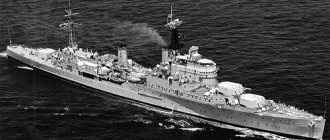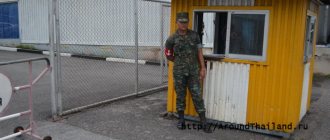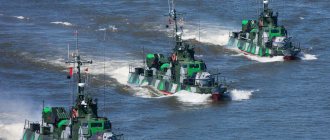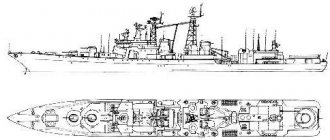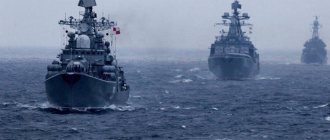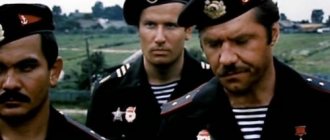The Russian Federation is a continental power. The Navy is one of the three pillars on which the country's power rests.
Protection of sea borders, protection in the open ocean, display of the flag - these are the tasks of the fleet that have been, are and will be faced by the Russian Navy.
Let's take a closer look at the Russian Navy, the history of its creation, what are the main goals and objectives it faces, the main composition and structure, what weapons and equipment are used today.
History of the creation of the Russian Navy
According to ancient Russian chronicles, the first warships appeared in the 12th century. Although, probably, they existed before, because the path “From the Varangians to the Greeks” has existed since time immemorial. The first documented victory of the Russian fleet occurred on July 22 (August 1), 1656 in the Battle of Kotlin during the Russian-Swedish War.
The history of the creation of the Russian Imperial Fleet (RIF), as it was called during the Russian Empire, begins in 1696 after the Azov campaigns of Peter I. The first warships were built in shipyards in Voronezh, and after the start of construction of the Baltic Fleet, construction began near modern St. Petersburg .
By 1725, the power of the RIF, although not in the first positions, was quite strong to be taken into account.
After the death of Peter I, during the reign of Peter II, the fleet began to wither away and was not given due attention. The ships were at the berths; there were no exercises or sea voyages. And only with the accession of Anna Ioannovna the situation began to change. A Military Naval Collegium was established under the leadership of Vice-Chancellor Count Andrei Osterman, which included Vice Admiral Count Nikolai Golovin, Vice Admiral Naum Senyavin, Vice Admiral Thomas Sanders, Rear Admiral Peter Bredal and Rear Admiral Vasily Dmitriev-Mamonov , management reform was carried out, new fleet staffs were introduced.
Also in 1732, the construction of ships in Arkhangelsk was restored. This gave a powerful impetus to Russian shipbuilding. The materials for building ships were practically nearby, and ships built from larch were no worse, or even better, than ships built in central Russia from ship oak. Convenient logistics also made it possible to speed up and reduce the cost of construction. For many years, Arkhangelsk became the base for the construction of the Baltic Fleet.
In the second half of the 18th century, the Russian fleet developed even faster. This was caused by direct military necessity, because. Russia's foreign policy intensified, and the Russian-Turkish wars for dominance in the Black Sea did not stop. For the first time in its history, Russia sent naval squadrons from the Baltic Sea to the Mediterranean. The transition was accompanied by many problems. Ships ran aground, were damaged during storms, and sailors got sick and died. If the first ship of the fleet arrived at its destination in November 1769, then the main part of the fleet arrived only in February 1770. But this did not stop the Russian sailors from going “with fire and sword” through the Turkish fleet and coastal fortresses.
During the Battle of Chesma in 1770, one of the most significant victories of the Russian fleet was won. Turkey's ability to operate in the Dardanelles and the Aegean Sea was blocked, which caused supply disruptions to the capital of the Ottoman Empire. In general, constant wars with Turkey in the middle and end of the 18th century led to the fact that by the end of the century the RIF became the third in terms of combat power in the world, after England and France. However, delays in the economic and industrial development of the country resulted in a lag in the development of the Russian fleet. And the Crimean War showed this well.
Despite the name, theaters of war (theatres of war) were located not only in the Crimea, but also in the Caucasus, the Far East, the Baltic and White Seas. The war revealed Russia's technical lag behind the leading powers, and only the heroism of the peoples of the Russian Empire prevented the war from ending with much more disastrous results.
After the Crimean War, a lot of effort and money was invested in the development of the fleet, and the fleet once again accelerated its development. Active construction of steam ships began, and many warships were purchased abroad.
At the beginning of the 20th century, the Russo-Japanese War broke out. The Japanese, with the fleet that the British supplied them, won the war, moreover, they slapped Russia in the face not without the help of their commanders, including the same Rozhdestvensky and Nebogatov.
After the war, the fleet fell back to 6th place in the world, however, it began to recover at a rapid pace. For example, on March 19, 1906, a new branch of the RIF forces was created - submarines. And to this day in Russia this day is the day of the submariner. In the same year, the “Small Shipbuilding Program” was adopted. Many ships were ordered from other countries, which led to the confiscation of the backlog of ships at German shipyards and a shortage of components from England.
The Russian Imperial Navy spent the First World War with dignity, despite the processes taking place in the state. The Black Sea Fleet dominated the Black Sea; in the Baltic, the Germans failed to realize their plans.
After the revolution and civil war, the tonnage of the fleet actually decreased to 16% of its pre-war value. The number of personnel decreased by two thirds. However, as soon as it got back on its feet, the Soviet Union began to pay increased attention to the fleet. Thus, on March 28, 1924, the Directorate of Naval Forces (UVMS) of the Red Army was organized, reporting directly to the People's Commissar for Military and Naval Affairs (People's Commissar of Military and Naval Affairs) of the USSR L. D. Trotsky.
Throughout the entire time, right up to the beginning of the Great Patriotic War, the fleet developed, and submarines were especially actively built. On June 22, 1941, the ship composition of the Workers' and Peasants' Red Fleet (RKKF) consisted of 3 battleships, 7 cruisers, 59 leaders and destroyers, 218 submarines, 269 torpedo boats, 22 patrol ships, 88 minesweepers and many other ships and boats, and also auxiliary vessels. There were 219 ships under construction.
The war for the fleet began earlier than anyone else, so the very first combat order was given at 03:06 on June 22, 1941 by the chief of staff of the Black Sea Fleet, Rear Admiral I. D. Eliseev. This was an order to open fire on German planes.
The main battles of the Great Patriotic War took place on land, so the fleet mainly acted to support ground forces. More than 400 thousand sailors were sent from ships to shore, mainly to the marines.
After the Second World War, the fleet continued its development and reached power by the 80s of the 20th century. Since 1955, boats with ballistic missiles have been adopted. In 1958, the first nuclear submarine was launched.
After the collapse of the USSR, the Russian Navy became much weaker. From 1,561 ships in 1985, 136 remained in 2010. However, let's hope that the fleet will be revived, as has happened more than once in its history.
The largest merchant fleet
Trade in the ocean is also actively developing, the number of ships with large displacement is growing: container ships, tankers and others. When legally registering a new ship, the home port is important. Sailors are well aware that strict registration and taxation conditions at home take a lot of effort, time and money. Therefore, it turned out that the largest merchant fleet in the world belongs to Panama.
Panama
A small state in America owns the Panama Canal and does not build large ships. Moreover, Panama is the owner of a huge fleet. It's all about the "flag of convenience". When registering a vessel in Panama, the owner pays a small tax and can recruit a crew for little money. Registration is often done online. Initially, the flag of Panama was chosen by American ships who wanted to sell alcohol to passengers during Prohibition. If in 2005 the number of Panama ships reached 4,688, today the figure has exceeded 9,000.
The flag of Panama turned out to be the most convenient for commercial and passenger ships around the world
Liberia
Liberia followed Panama's example and began providing simplified registration. It has been talked about for a long time that the number of merchant fleets will grow. Liberia is one of the poorest countries in the world; an important source of its income is the use of a “flag of convenience”.
Incidents involving ships flying the flag of Liberia are increasingly occurring around the world.
China
China is strengthening its position at sea. The number of trade transactions in the Pacific and Indian Oceans is growing. The shipbuilding sector is controlled by the state. The industry began to grow in 1999. Today, China's total tonnage exceeds 170 gross tons.
China owns the world's largest ore tanker
Japan
After 2010, there was an increase in cargo transportation in Japan. The number of ships flying the country's flag increased from 673 to 2070 units. The main route lies in the Pacific Ocean.
A large number of orders for the construction of ships are carried out by Mitsubishi Heavy Industries
Singapore
Fifth place on the list is occupied by the economic leader of Southeast Asia, Singapore. The number of dry cargo ships, tankers, container ships, and refrigerators increases every year. The reason for registering in Singapore is the convenience of the flag. It is noteworthy that even landlocked Mongolia, Bolivia and Moldova provide maritime registration and have a fleet.
Port of Singapore
Goals and objectives of the Navy
The Navy is primarily a military branch that has the authority to use weapons when necessary.
The main goals currently assigned to the Navy are:
- Ensuring the security of the country's sovereignty in the waters, that is, readiness to repel an armed attack.
- Providing artillery fire support for ground forces. Modern Russian ships are equipped with guns that are as powerful as field artillery.
- Creating safe passage for merchant ships and their activities. Today, maritime attacks on ships are common. In order to ensure that if there is a threat of a ship being captured by sea robbers, there is an opportunity to free them, and there are separate units of the Navy.
- Deterring other states from thinking about attacking Russia. As long as the Russian Federation has the most modern armed ships, significantly superior in firepower to similar ships of other states, no country will decide to attack a stronger enemy. In addition, Russian warships are located in all maritime spaces belonging to Russian sovereignty. This allows you to control all ship maneuvers of other countries. The Russian Federation borders on the sea with the territories of many other countries - the USA, Japan, Poland, Lithuania, Finland, etc. If there is a threat of an attack from one of them, Russia can strike ahead of the curve.
- Participation in international exercises allows the Russian Federation to demonstrate its power on the world stage.
Structure of the Russian Navy
The Navy includes the following forces:
- Surface forces.
- Submarine forces.
- Naval aviation: coastal;
- deck;
The Navy also includes special forces units, logistics units and units.
In addition, there is the Hydrographic Service of the Navy, which belongs to the Main Directorate of Navigation and Oceanography of the Ministry of Defense of the Russian Federation.
Surface forces
Surface forces are a branch of the Navy.
Surface forces are used for:
- protection of sea communications;
- transportation and cover of landings;
- mining and demining of water theaters of war and territorial waters;
- ensuring the exit and deployment of submarine forces, their return to bases.
The main properties of surface forces are great striking power, high maneuverability, and a wide spatial scope of operations.
The performance of combat missions by surface forces can be carried out either independently or in cooperation with other branches of the naval forces.
Submarine forces
Submarine forces are used to attack maritime and continental targets and for reconnaissance purposes. Nuclear submarines armed with ballistic and cruise missiles are part of the triad of Russian strategic forces. The fleet also operates diesel submarines of various classes, armed with both torpedoes and missiles.
Naval aviation
Naval aviation is intended for:
- search, target designation and destruction of enemy surface ships and submarines in the ocean;
- bombing and missile strikes;
- repelling attacks by aircraft and anti-ship missiles.
Also, naval aviation can be involved in laying mine and anti-submarine barriers, electronic warfare (EW), air transportation and landing, search and rescue operations (SRP) at sea and on land.
Coastal Fleet Forces
Tasks of the coastal troops (BC) of the fleet:
- coastal defense (naval bases, ports, bases and coastal facilities);
- conducting combat operations as part of sea, air and airborne assault forces.
Coastal troops include 2 types of troops: coastal missile and artillery troops and marine infantry.
Each branch of the military solves certain target tasks independently and in cooperation with other branches of the military forces and naval forces, as well as with formations and units of other branches of the Armed Forces and branches of the military.
The main organizational units of the military units are brigades and battalions (divisions).
The warheads are equipped primarily with weapons and equipment of the combined arms type, however, they are armed with coastal missile systems (CBMs), anti-ship guided missiles (ASMs), stationary and mobile artillery installations designed to destroy sea and ground targets, special (marine) reconnaissance equipment, etc.
Weapons and equipment
Includes airplanes and helicopters for various purposes.
Naval aviation is divided into deck-based and shore-based aviation. Until 2011, the naval aviation of the Russian Navy included: missile-carrying, attack, fighter, anti-submarine, search and rescue, transport and special aviation.
After the military reform of 2011, the state and prospects of naval aviation are vague. According to available information, its organizational structure currently includes 7 air bases and the 279th naval air regiment assigned to the Admiral Kuznetsov aircraft carrier.
About 300 aircraft remain in naval aviation. Of them:
- 24 Su-24M/MR,
- 21 Su-33 (in flight condition no more than 12),
- 16 Tu-142 (in flight condition no more than 10),
- 4 Su-25 UTG (279th naval aviation regiment),
- 16 Il-38 (in flight condition no more than 10),
- 7 Be-12 (mainly for the Black Sea Fleet, will be decommissioned in the near future),
- 95 Ka-27 (no more than 70 operational),
- 10 Ka-29 (assigned to the Marines),
- 16 Mi-8,
- 11 An-12 (several in reconnaissance and electronic warfare versions),
- 47 An-24 and An-26,
- 8 An-72,
- 5 Tu-134,
- 2 Tu-154,
- 2 IL-18,
- 1 IL-22,
- 1 IL-20,
- 4 Tu-134UBL.
Of these, no more than 43% of the total number are technically serviceable and capable of performing combat missions in full.
Before the reform, the Navy aviation had two fighter regiments, the 698th OGIAP with Su-27 fighters and the 865th IAP with MiG-31 fighters. They are currently transferred to the Air Force.
Attack and naval missile-carrying aircraft (Tu-22M3) were eliminated. The latter looks more than strange, given that the MRA has long been considered one of the main and most effective means of combating the AUG of a potential enemy near our maritime borders. In 2011, all Tu-22M3 missile-carrying bombers of naval missile-carrying aviation, consisting of three squadrons, were hastily transferred to the Air Force Long-Range Aviation. Thus, all Tu-22M3 missile carriers are now concentrated in the Air Force, and the Navy has lost an important part of its combat potential.
Apparently, this decision was dictated not so much by military considerations as by the realities of today. Due to long-term catastrophic underfunding, combat training of naval aviation pilots was carried out at a more than modest level; only one 1/3 of the crews could be considered combat ready; Tu-22M3 aircraft have not been modernized for a long time. In fact, in the 1990s and early 2000s, only those who learned it in Soviet times could fly in naval aviation. At the same time, the combat effectiveness of Long-Range Aviation in modern Russia continues to be at least somehow maintained. The missile carriers were transferred to places where they are still able to service them and can fly them. In addition, the collection of all Tu-22M3 aircraft in one structure, in theory, should reduce the cost of their maintenance. Currently, out of 150 aircraft of this type available to Russia, only 40 are combat-ready. It is reported that thirty Tu-22M3 will undergo a deep modernization with the replacement of all electronics and will receive a new high-precision missile X-32.
The rest of the Tu-22M3 are in non-flying condition for various reasons and are “mothballed.” Judging by the photos, the condition of these far from old cars is not very good. If we talk about completing such a task as the destruction of at least one Nimitz-class aircraft carrier, then this will require at least 30 Tu-22M3, that is, almost all available combat-ready vehicles. If you divide 40 missile carriers between two structures, it turns out that the fight against AUG is beyond the capabilities of the missile-carrying units of either of them.
In general, after the reform, naval aviation was deprived of most of its striking power, and is currently concentrating on the tasks of anti-submarine defense (ASW), patrol and search and rescue operations, while maintaining a single regiment of ship-based fighters and limited capabilities in its structure. carrying out strike missions from ground airfields.
The patrols carried out by Il-38 and Tu-142M3/MK aircraft in the Pacific region and the Arctic are a demonstration of military presence and have important political significance. Due to Russia's serious political and economic interests in the Arctic, maritime patrol aircraft monitor ice conditions and the movements of foreign ships in this region.
Another important function of naval aviation is anti-submarine warfare. It is also carried out by Il-38 and Tu-142M3/MK aircraft. The anti-submarine function in peacetime includes "offensive" and "defensive" combat patrols. The first includes monitoring the areas of possible presence of SSBNs of a potential enemy, primarily American submarines. In the second case, Russian anti-submarine aviation covers the probable patrol areas of its strategic missile carriers, monitoring the activity of enemy submarines that may pose a threat to Russian SSBNs when they are on combat duty.
The Russian Navy also has specialized Ka-27PL anti-submarine helicopters. These are reliable machines that still have a significant service life, just like the Ka-27PS search and rescue helicopters. The Black Sea Fleet has 8 Mi-8 helicopters equipped with electronic warfare equipment.
Coastal strike aviation of the Russian Navy is represented by the only 43rd naval attack squadron of the Black Sea Fleet, consisting of 18 Su-24 front-line bombers and 4 Su-24MR reconnaissance aircraft. It is based in Crimea at the Gvardeyskoye airfield. The squadron was not transferred to the Air Force because this could not be done without international complications.
Also equipped with the Su-24, the 4th Separate Marine Attack Aviation Regiment (OMSHAP), based in Chernyakhovsk (Kaliningrad region), became the 7052nd air base in 2009, but was transferred to the Air Force in March 2011.
The Navy's transport aviation has at its disposal the An-12, An-24 aircraft and one An-72 short take-off and landing aircraft.
The Black Sea Fleet has three or four Be-12PS turboprop amphibians, which are mainly used for search and rescue and patrol operations. These machines are significantly outdated and have expired.
Moral and physical obsolescence of the flight fleet is a serious problem for the Russian Navy aviation. So far, it has only been partially resolved. Thus, new Ka-52K helicopters will be purchased for the acquired Mistral UDC, Ka-31 AWACS helicopters and MiG-29K carrier-based fighters for the Kuznetsov aircraft carrier. The Su-33 fighter jets are also being modernized.
The training of naval aviation pilots of the Russian Navy is carried out by the 859th Naval Aviation Training Center in Yeisk on the Sea of Azov. It carries out both retraining of pilots for new types of aircraft and training of ground personnel.
To train carrier-based aviation pilots of the Russian Navy, the unique NITKA training ground, located in Crimea and owned by the Ukrainian Navy, is used. In 2008-2010 Due to international complications caused by the “Five Day War” with Georgia, the Russians were deprived of the opportunity to conduct training at the complex. Accordingly, for three years, the training of young pilots of the 279th naval aviation regiment was greatly hampered, since pilots are allowed to fly from the deck of the Kuznetsov aircraft carrier only after successful training at NITKA. In 2013, Russia refused to use the Ukrainian THREAD, as it was actively building its own, more advanced THREAD in Yeisk. In July 2013, the first test flights of the Su-25UTG and MiG-29KUB aircraft were successfully carried out on it.
Operational-strategic formations
The operational-strategic formations of the Russian Navy are:
- Baltic Fleet with headquarters in Kaliningrad. Ship composition: 3 diesel submarines, 2 destroyers, 3 corvettes, 2 patrol ships, 4 small missile ships, 7 small anti-submarine ships, 7 missile boats, 5 base minesweepers, 14 raid minesweepers, 4 large landing ships, 2 small landing ships VP, 6 landing boats. Total: submarines - 3, surface ships - 56.
- Northern Fleet with headquarters in Severomorsk. Ship composition: 10 nuclear-powered ballistic missile submarines, 3 nuclear-powered cruise missile submarines, 14 attack nuclear-powered submarines, 9 nuclear-powered special-purpose submarines, 1 diesel-powered special-purpose submarine, 6 diesel-powered submarines, 1 heavy aircraft-carrying cruiser, 2 heavy nuclear-powered submarines missile cruisers, 1 missile cruiser, 5 BOD, 1 destroyer, 3 small missile ships, 1 gun boat, 6 small anti-submarine ships, 4 sea minesweepers, 6 base minesweepers, 1 raid minesweeper, 4 large landing ships, 4 landing boats. Total: submarines - 43, surface ships - 39.
- Black Sea Fleet with headquarters in Sevastopol. Ship composition: 2 diesel submarines, 1 missile cruiser, 2 BOD, 3 SKR, 7 MPK, 4 MRK, 5 missile boats, 7 sea minesweepers, 2 base minesweepers, 2 raid minesweepers, 7 large landing ships, 2 landing boats. Total: submarines - 2, surface ships - 41.
- Pacific Fleet with headquarters in Vladivostok. Ship composition: 3 nuclear-powered ballistic missile submarines, 5 nuclear-powered cruise missile submarines, 5 multi-purpose nuclear submarines, 8 diesel submarines, 1 heavy nuclear-powered missile cruiser, 1 missile cruiser, 4 large anti-submarine ships, 3 destroyers, 8 small anti-submarine ships, 4 small missile ships, 11 missile boats, 2 sea minesweepers, 7 base minesweepers, 1 raid minesweeper, 4 large landing ships, 4 landing boats. Total: submarines - 21, surface ships - 50.
- Caspian flotilla with headquarters in Astrakhan. Ship composition: 2 patrol ships, 4 small artillery ships, 5 missile boats, 5 artillery boats, 2 base minesweepers, 5 raid minesweepers, 7 landing boats. Total: surface ships - 28.
The Northern and Pacific fleets are full-fledged ocean-going fleets. Their ships can conduct all types of naval operations in the far ocean zone. Only these two fleets of the Russian Navy have submarines and SSBNs. All Russian missile cruisers are also concentrated here except the flagship of the Black Sea Fleet, the RKR Moskva.
The Baltic and Black Sea fleets are predominantly maritime fleets. Their ships can also enter the World Ocean, but only in global peace, to carry out expeditionary operations against an obviously weaker enemy.
Caspian flotilla
73rd brigade of water area protection ships
External attributes: one anchor - a brigade, halberds - a guard unit.
Central emblem: silver waves, as a symbol of the Caspian Sea, and a golden triangle, symbolizing the Volga River delta and the brigade base - Zolotoy Zaton.
249 missile boat division
External attributes: absence of anchors - division, two booms - subordination to a brigade of missile boats, booms - formation of the Republic of Kazakhstan.
Central emblem: from a higher connection, with a change in background color.
198th minesweeper division
External attributes: absence of anchors - division, halberd - subordination to the KOVR brigade, hooks - formation of minesweepers.
Central emblem: from a higher connection, with a change in background color.
106th brigade of water area protection ships
External attributes: one anchor - a brigade, halberds - a guard unit.
The central emblem: the golden sun from the coat of arms of the Republic of Dagestan and the crescent, symbolizing the Islamic region of origin.
327 surface ships division
External attributes: absence of anchors - division, halberd - subordination to the KOVR brigade, boom and hook - connection of boats and minesweepers.
Central emblem: from a higher connection, with a change in background color.
242 landing ship division
External attributes: absence of anchors - division, halberd - subordination to the KOVR brigade, boarding hooks - connection of landing ships.
Central emblem: from a higher connection, with a change in background color.
Armament of the Russian Navy
The Navy is armed with both nuclear and non-nuclear ammunition. For example, SSBNs (Special Purpose Missile Submarines) are armed with nuclear-tipped ballistic missiles such as the Bulava and Sineva. At the same time, the fleet is actively using cruise missiles with a conventional Caliber warhead, which can operate against both surface and ground targets.
The Caliber complex was actively used in Syria. The fleet is also armed with air defense and anti-aircraft defense systems, such as the Poliment-Redut complexes, the Kortik air defense system and others.
However, cannon armament remains an important part of the fleet's armament, for example, the AK-130 universal shipborne artillery mount (AU). The installation has a high rate of fire (up to 90 rounds per minute). The presence of mechanisms for automatic reloading of ammunition allows you to release all the ammunition before the cellars are completely empty without the participation of an additional team.
The AU has sight correction devices for splashes of falling shells and a sighting post for firing at coastal targets. The gun, thanks to its high rate of fire and the presence of several types of specialized projectiles, can conduct effective anti-aircraft fire (the ammunition includes projectiles with remote and radar fuses).
In general, the armament of the Russian Navy allows it to carry out all the tasks assigned to it to protect the country, its coasts and interests in the coastal zone and in the World Ocean.
Navy flags
- The flag of the Navy is the St. Andrew's Cross. This flag is hung at the stern of the ships of the fleet.
- Also, on ships of the Navy of the 1st and 2nd ranks, a huys (bow flag) is hoisted.
- On ships with the rank of Guards, the Guards stern flag is flown.
- On ships awarded with orders, a stern flag containing an image of the order is hung.
- On Guards ships awarded the order, a stern flag with a Guards ribbon and an image of the order is raised.
In general, there are a huge number of flags in the Navy, ranging from flags of commanders of various ranks to flags of fleet auxiliary forces, etc.
For example, the flag of the Supreme Commander-in-Chief of the Armed Forces of the Russian Federation.
Russian Navy Day
The official celebration of the Day of the Navy of the Russian Federation was established by Decree of the President of the Russian Federation in 2006. It is celebrated on the last Sunday of July.
Navy Day is a professional holiday for military sailors, military personnel of the Russian Navy, veterans, workers of shipbuilding and ship repair enterprises.
Many ceremonial events are planned for Navy Day, and naval parades will be held at fleet bases. Traditionally, the celebration involves concerts, congratulations from the command of the crews of ships and vessels, naval aviation squadrons, personnel of coastal units and everyone who serves in the Navy. Those who distinguished themselves are given awards, certificates and valuable gifts. Navy veterans also accept congratulations.
Combat composition
Before 2008, the structure of naval aviation looked like this:
- Pacific Fleet - transport squadron No. 71, Knevichi base, composition of Tu-134, An-26, An-24 and An-12; fighter regiment No. 865, Elizovo base, MiG-31 squadron; mixed regiment No. 568, Kamenny Brook base, composed of Tu-142M3, Tu-142MR and Tu-22M3; mixed regiment No. 317, Elizovo base, consisting of An-26, Mi-8 and -38; anti-submarine regiment No. 289, Nikolaevka base, composition of Ka-29, Ka-27, Il-18 and Il-38;
- Black Sea Fleet - assault regiment No. 43, Gvardeyskoye base, composition of Su-24MR and Su-24; mixed regiment No. 917, Kacha base, composed of Be-12, An-26 and An-2; anti-submarine helicopter regiment No. 25, Kacha base, composition of Mi-8, Mi-14 and Ka-27;
- SF – anti-submarine squadron No. 73, Kipelovo base, Tu-142; missile-carrying guards regiment No. 924, Olenegorsk base, Tu-22M3 train; anti-submarine helicopter Red Banner Regiment No. 830, Severomorsk-1 base, composition of Ka-29 and Ka-27; mixed regiment No. 403, Severomorsk-1 base, composed of Tu-134, Il-38, An-26 and An-12; fighter regiment No. 279, Severomorsk-3 base, composition of MiG-29KUB, MiG-29K, Su-25UTG and Su-33;
- BF – transport squadron No. 398, Khrabrovo base, consisting of An-26 and An-24; anti-submarine helicopter squadron No. 396, Donskoye base, composition of Ka-29 and Ka-27; helicopter squadron No. 125, Chkalovsk base, composition of Mi-24 and Mi-8; fighter regiment No. 689, Chkalovsk base, Su-27 train; assault guards regiment No. 4, Chernyakhovsk base, Su-24 train.
865th Nikolsky Red Banner Fighter Regiment
Carrier-based aviation of the Russian Federation
Since the only TAVKR in Russia is assigned to the Northern Fleet, carrier-based aviation of the Russian Navy is available only in the Northern Fleet. This ship does not fall under the category of aircraft carrier; in comparison with US strike groups, the following situation has developed:
- one Russian carrier cruiser against 10 full-fledged American aircraft carriers;
- of the projected 50 combat units on board Admiral Kuznetsov there are 4 MiG-29KUB, 10 MiG-29K, 2 Su-25UTG and 14 Su-33, that is, 30 units;
- due to the lack of encirclement ships, the TAVKR will not be able to use its main advantage - the P-700 Granit and P-1000 Vulcan.
Incomplete loading of TAVKR
P-700 Granite
However, in 2022–2022 it is planned to equip naval aviation units with 100 units of new aircraft.
